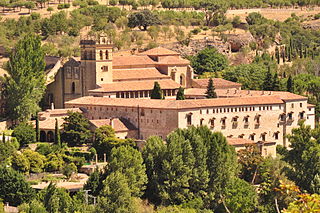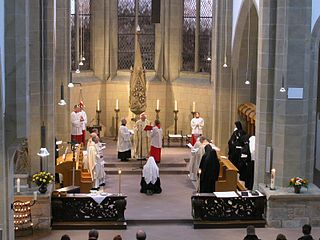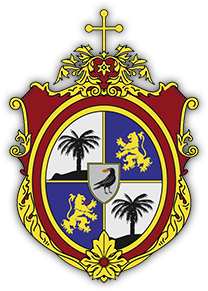
A novice in Catholic law and tradition, is a prospective member of a religious institute who is being tried and being proven for suitability of admission to a religious order of brothers, sisters or monks.
A religious institute is a type of institute of consecrated life in the Catholic Church where its members take religious vows and lead a life in community with fellow members. Religious institutes are one of the two types of institutes of consecrated life; the other is that of the secular institute, where its members are "living in the world".

A monk is a person who practices religious asceticism by monastic living, either alone or with any number of other monks. A monk may be a person who decides to dedicate his life to serving all other living beings, or to be an ascetic who voluntarily chooses to leave mainstream society and live his or her life in prayer and contemplation. The concept is ancient and can be seen in many religions and in philosophy.

A nun is a member of a religious community of women, typically living under vows of poverty, chastity, and obedience in the enclosure of a monastery. Communities of nuns exist in numerous religious traditions, including Buddhism, Christianity, Hinduism, Jainism, and Taoism.
Novices are not admitted to vows until they have successfully completed the prescribed period of training and proving, called the novitiate. In the Middle Ages novices typically would have dormitories in separate areas within a monastery; an early Cistercian monastery, Royal Monastery of Our Lady of the Wheel, founded in 1202, has this chamber clearly visible today.

The novitiate, also called the noviciate, is the period of training and preparation that a Christian novice monastic, apostolic, or member of a religious order undergoes prior to taking vows in order to discern whether he or she is called to vowed religious life. It often includes times of intense study, prayer, living in community, studying the vowed life, deepening one's relationship with God, and deepening one's self-awareness. It is a time of creating a new way of being in the world. The novitiate stage in most communities is a two-year period of formation. These years are "Sabbath time" to deepen one's relationship with God, to intensify the living out of the community's mission and charism, and to foster human growth. The novitiate experience for many communities includes a concentrated program of prayer, study, reflection and limited ministerial engagement.

In the history of Europe, the Middle Ages lasted from the 5th to the 15th century. It began with the fall of the Western Roman Empire and merged into the Renaissance and the Age of Discovery. The Middle Ages is the middle period of the three traditional divisions of Western history: classical antiquity, the medieval period, and the modern period. The medieval period is itself subdivided into the Early, High, and Late Middle Ages.

A monastery is a building or complex of buildings comprising the domestic quarters and workplaces of monastics, monks or nuns, whether living in communities or alone (hermits). A monastery generally includes a place reserved for prayer which may be a chapel, church, or temple, and may also serve as an oratory.
Earlier, different orders followed their own rules governing the length and conditions of the novitiate. However, in response to the Protestant Reformation, the Council of Trent legislated the length and conditions by which anyone aspiring to become a monk is obliged to be a novice; the usual period is at least one year, [1] depending on the aptitude of the candidate.

The Council of Trent, held between 1545 and 1563 in Trent, was the 19th ecumenical council of the Catholic Church. Prompted by the Protestant Reformation, it has been described as the embodiment of the Counter-Reformation.
An aptitude is a component of a competence to do a certain kind of work at a certain level. Outstanding aptitude can be considered "talent". An aptitude may be physical or mental. Aptitude is inborn potential to do certain kinds of work whether developed or undeveloped. Ability is developed knowledge, understanding, learned or acquired abilities (skills) or attitude. The innate nature of aptitude is in contrast to skills and achievement, which represent knowledge or ability that is gained through learning.
A candidate, or nominee, is the prospective recipient of an award or honor, or a person seeking or being considered for some kind of position; for example:







